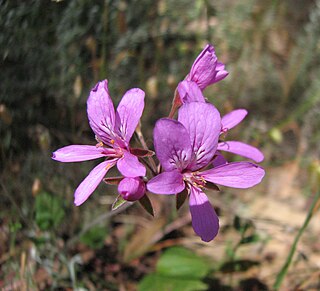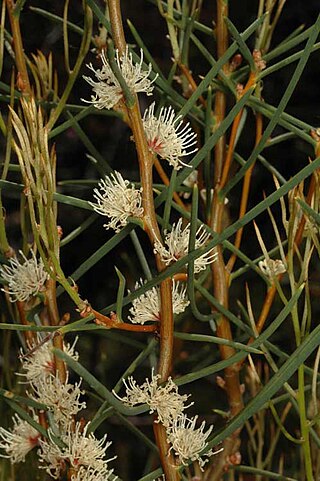
Epacris impressa, also known as common heath, is a plant of the heath family, Ericaceae, that is native to southeast Australia. French botanist Jacques Labillardière collected the species in 1793 and described it in 1805. Four forms have been identified, but no subspecies are recognised. Growing in heathland, shrubland or open forest, it is generally a small shrub around 0.5 to 1 m tall, with small stiff leaves. The red, pink or white tube-like flowers appear from late autumn to early spring. Honeyeater birds, particularly the eastern spinebill, feed upon the nectar of the flowers. It regenerates after bushfire by seed or by resprouting.

Glycyrrhiza is a genus of about 20 accepted species in the legume family (Fabaceae), with a subcosmopolitan distribution in Asia, Australia, Europe, and the Americas.

Brachychiton rupestris, commonly known as the narrow-leaved bottle tree or Queensland bottle tree, is a tree in the family Malvaceae native to Queensland, Australia. Described by Sir Thomas Mitchell and John Lindley in 1848, it gained its name from its bulbous trunk, which can be up to 3.5 metres (11 ft) diameter at breast height (DBH). Reaching 10–25 metres (33–82 ft) high, the Queensland bottle tree is deciduous, losing its leaves between September and December. The leaves are simple or divided, with one or more narrow leaf blades up to 11 centimetres (4 in) long and 2 centimetres (0.8 in) wide. Cream-coloured flowers appear from September to November, and are followed by woody boat-shaped follicles that ripen from November to May. No subspecies are recognised.

Grevillea aquifolium is a shrubby or scrambling plant endemic to South Australia and Victoria. Common names include holly grevillea, prickly grevillea or variable prickly grevillea. It occurs naturally in woodland, open forest and heathland.

Acacia acinacea, commonly known as gold dust wattle, is a flowering shrub. It is native to south eastern Australia and lives for 15 years on average. This wattle species is tolerant of drought and frost. It is also known as wreath wattle or round-leaf wattle.

Amyema quandang is a species of hemi-parasitic shrub which is widespread throughout the mainland of Australia, especially arid inland regions, sometimes referred to as the grey mistletoe.

Acacia farinosa, commonly known as mealy wattle, is a shrub that is endemic to Australia. It grows to between 1 and 2 metres high and has ascending phyllodes. The yellow globular flower heads generally appear between August and October in its native range. These are followed by curled and twisted pods which are up to 6 cm long and 2–3 mm wide.

Tetratheca ciliata, commonly known as pink bells, is a small shrub in the family Elaeocarpaceae. It is endemic to southern Australia.

Acacia exudans, also known as Casterton wattle, is a shrub species that is endemic to Australia. The species was formally described by English botanist John Lindley in 1838 from material collected on Thomas Mitchell's expedition near Casterton, Victoria in 1836. The description was published in Mitchell's Three Expeditions into the interior of Eastern Australia.

Acacia mitchellii, commonly known as Mitchell's wattle, is an erect or spreading shrub which is endemic to Australia. It grows to up to 2 metres high and has small bipinnate leaves. The pale yellow globular flowerheads appear in groups of 1 to 3 in the axils of the phyllodes followed by straight or curved seed pods which are 1.8 to 5 cm long and 4 to 8 mm wide.

Acacia aspera, commonly known as rough wattle, is a spreading shrub which is endemic to south-eastern Australia. It grows to up to 2 metres high and has phyllodes which are 10 to 30 mm long and 2 –4 mm wide. The pale yellow to gold globular flowerheads appear singly or in groups of two in the axils of the phyllodes in July to September, followed by curved or coiled seed pods which are 20 to 70 mm long and 3 to 5 mm wide.

Leionema bilobum, commonly known as notched phebalium, is a shrub species of the family Rutaceae. It is endemic to south-eastern Australia. The species was first formally described by English botanist John Lindley from material collected during Thomas Mitchell's exploration of the Grampians. His description was published in 1838 in Three Expeditions into the interior of Eastern Australia. Lindley gave it the name Phebalium bilobum. The species was transferred to the genus Leionema by Paul G. Wilson in 2003. Four subspecies were formally described in 2006:

Pelargonium rodneyanum, commonly known as magenta storksbill, is a perennial herb species that is endemic to Australia. It grows to 40 cm high and has leaves with 5 to 7 shallow lobes. Dark pink flowers appear between October and February in the species native range.
Hibbertia incana is a small shrub that is native to south-eastern continental Australia. It grows to between 0.2 and 1.5 metres high and has yellow flowers which appear between October and December in the species native range.
Philotheca pungens, commonly known as prickly waxflower, is a species of flowering plant in the family Rutaceae and is endemic to south-eastern Australia. It is an undershrub with linear to narrow oblong or needle-like leaves and white flowers usually arranged singly in leaf axils.

Hakea mitchellii, commonly known as desert hakea, is a shrub species in the family Proteaceae.

Melaleuca nervosa, commonly known as fibrebark, is a shrub or tree in the myrtle family Myrtaceae and is endemic to northern Australia. It is a narrow-leaved, tropical paperbark with yellow-green and red-flowering forms. As with some other melaleucas, this species has many uses to Indigenous Australians.

Acacia sclerophylla, commonly known as the hard-leaf wattle, is a shrub of the genus Acacia and the subgenus Plurinerves and is endemic to southern parts of Australia.

Sclerolaena bicornis, commonly known as goathead burr, is a perennial shrub in the Amaranthaceae family, native to inland Australia, and found in Queensland, the Northern Territory, South Australia, New South Wales, and Western Australia The Walmajarri people of the Kimberley know the plant as Paka.

Hybanthus floribundus is a plant in the Violaceae family, found in southern Western Australia, southern South Australia, Victoria and southern New South Wales.


















